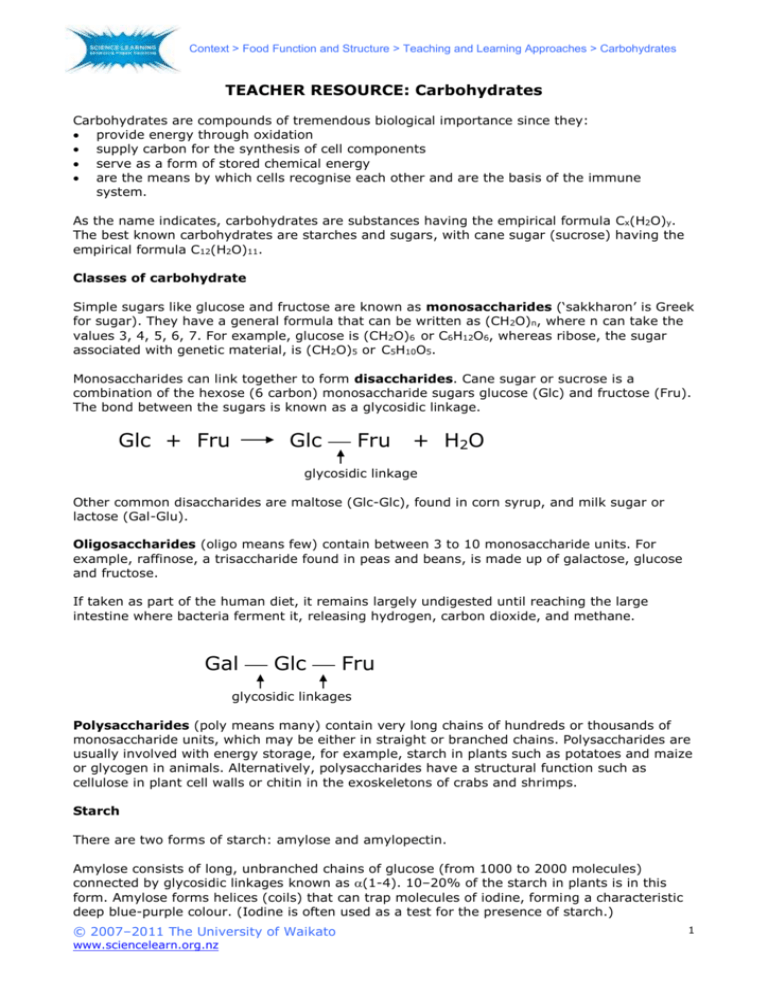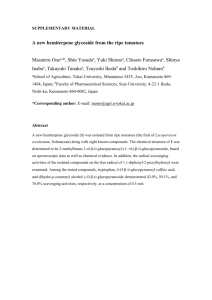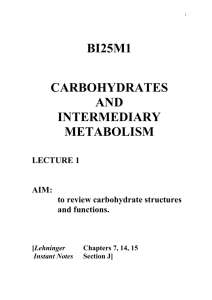Carbohydrates - Science Learning Hub
advertisement

Context > Food Function and Structure > Teaching and Learning Approaches > Carbohydrates TEACHER RESOURCE: Carbohydrates Carbohydrates are compounds of tremendous biological importance since they: provide energy through oxidation supply carbon for the synthesis of cell components serve as a form of stored chemical energy are the means by which cells recognise each other and are the basis of the immune system. As the name indicates, carbohydrates are substances having the empirical formula Cx(H2O)y. The best known carbohydrates are starches and sugars, with cane sugar (sucrose) having the empirical formula C12(H2O)11. Classes of carbohydrate Simple sugars like glucose and fructose are known as monosaccharides (‘sakkharon’ is Greek for sugar). They have a general formula that can be written as (CH 2O)n, where n can take the values 3, 4, 5, 6, 7. For example, glucose is (CH2O)6 or C6H12O6, whereas ribose, the sugar associated with genetic material, is (CH2O)5 or C5H10O5. Monosaccharides can link together to form disaccharides. Cane sugar or sucrose is a combination of the hexose (6 carbon) monosaccharide sugars glucose (Glc) and fructose (Fru). The bond between the sugars is known as a glycosidic linkage. Glc + Fru Glc Fru + H 2O glycosidic linkage Other common disaccharides are maltose (Glc-Glc), found in corn syrup, and milk sugar or lactose (Gal-Glu). Oligosaccharides (oligo means few) contain between 3 to 10 monosaccharide units. For example, raffinose, a trisaccharide found in peas and beans, is made up of galactose, glucose and fructose. If taken as part of the human diet, it remains largely undigested until reaching the large intestine where bacteria ferment it, releasing hydrogen, carbon dioxide, and methane. Gal Glc Fru glycosidic linkages Polysaccharides (poly means many) contain very long chains of hundreds or thousands of monosaccharide units, which may be either in straight or branched chains. Polysaccharides are usually involved with energy storage, for example, starch in plants such as potatoes and maize or glycogen in animals. Alternatively, polysaccharides have a structural function such as cellulose in plant cell walls or chitin in the exoskeletons of crabs and shrimps. Starch There are two forms of starch: amylose and amylopectin. Amylose consists of long, unbranched chains of glucose (from 1000 to 2000 molecules) connected by glycosidic linkages known as (1-4). 10–20% of the starch in plants is in this form. Amylose forms helices (coils) that can trap molecules of iodine, forming a characteristic deep blue-purple colour. (Iodine is often used as a test for the presence of starch.) © 2007–2011 The University of Waikato www.sciencelearn.org.nz 1 Context > Food Function and Structure > Teaching and Learning Approaches > Carbohydrates Glc Glc Glc Glc Glc Glc Glc Glc Glc glycosidic linkages in amylose Amylopectin consists of long chains of glucose (up to 105 molecules) connected by (1-4) glycosidic linkages, with (1-6) branches every 24 to 30 glucose units along the chain. 80– 90% of the starch in plants is in this form. Glc Glc Glc (Glc Glc Glc)10 Glc Glc Glc Glc Glc © 2007–2011 The University of Waikato www.sciencelearn.org.nz 2 Context > Food Function and Structure > Teaching and Learning Approaches > Carbohydrates Glycogen Glycogen, also known as animal starch, is structurally similar to amylopectin, containing both glycosidic linkages and branch points. Glycogen is even more highly branched, however, with branches occurring every 8 to 12 glucose units. Glycogen is abundant in the liver and muscles; on hydrolysis, it forms glucose, which maintains normal blood sugar level and provides energy. G © 2007–2011 The University of Waikato www.sciencelearn.org.nz 3 Context > Food Function and Structure > Teaching and Learning Approaches > Carbohydrates G G G (G G G)3 G G G G G G G Cellulose Cellulose is a polymer consisting of long, unbranched chains of glucose connected by (1-4) glycosidic linkages; it may contain from 300 to 3000 glucose units in one molecule. Because of the -linkages, cellulose has a different overall shape from amylose, forming extended straight chains that bond to each other, resulting in a very rigid structure. © 2007–2011 The University of Waikato www.sciencelearn.org.nz 4 Context > Food Function and Structure > Teaching and Learning Approaches > Carbohydrates Cellulose is an important structural polysaccharide and is the single most abundant organic compound on earth. It is the material in plant cell walls that provides strength and rigidity; wood is 50% cellulose. Humans lack the enzymes needed to digest cellulose in the small intestine, but bacteria present in the large intestine can ferment some cellulose into short chain fatty acids such as acetic acid and butyric acid. These serve as a source of energy for the bacteria, as well as the cells lining the intestine. Cellulose graphic courtesy of the U.S. Department of Energy Genome Programs http://genomics.energy.gov. © 2007–2011 The University of Waikato www.sciencelearn.org.nz 5






